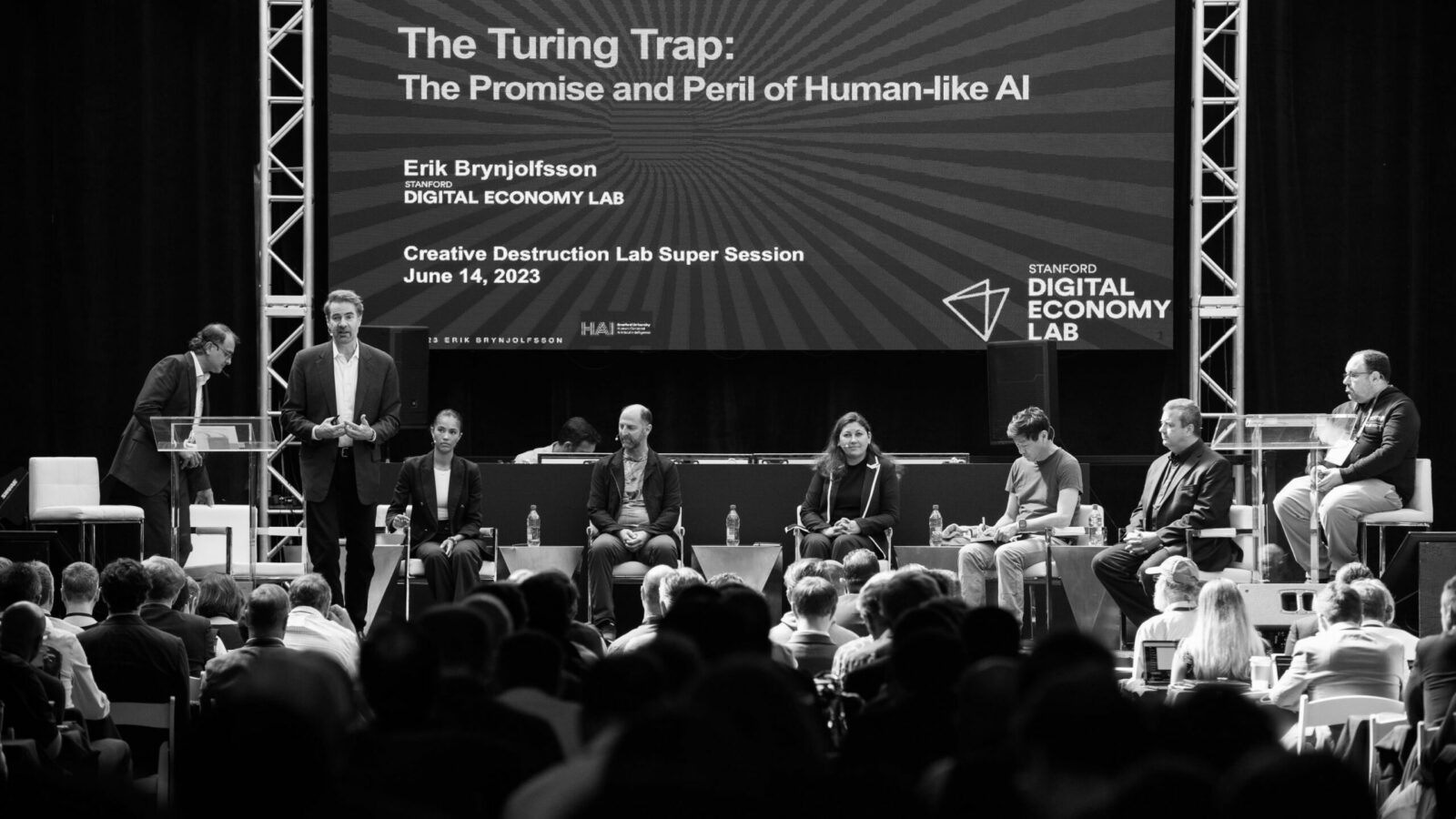What is the future of artificial intelligence? The question has been a hot topic all year but it took centre stage at Super Session, the grand finale event of Creative Destruction Lab’s (CDL) 2022/23 program year. Global graduating ventures were invited to attend two days of discussions, debates and roundtables at the Toronto Event Centre along with policymakers, innovators, venture capitalists, thought leaders and academics.
Among the distinguished guests were Erik Brynjolfsson, the Jerry Yang and Akiko Yamazaki professor and senior fellow at the Stanford Institute for Human-Centered AI (HAI) and director of the Stanford Digital Economy Lab, and Joshua Gans, the Jeffrey S. Skoll chair of technical innovation and entrepreneurship and professor at the Rotman School of Management and chief economist for CDL at the University of Toronto. The pair debated the resolution: “Be it resolved that human-like intelligence is the wrong focus for our work.” Brynjolfsson argued in favour, while Gans opposed.
A leading expert on the digital economy and author of The Turing Trap: The Promise and Peril of Human-like AI, Brynjolfsson’s research focuses on the impact of information technology on business strategy, productivity and performance. He believes that the goal of achieving human-like intelligence is not ambitious enough. Calculators are better at math than people, he noted during the debate, adding that AI should aim to surpass the limits of our cognitive abilities. Brynjolfsson argued for artificial intelligence that augments our productivity and efficiency, rather than AI which seeks to automate or replace jobs. Enhancing performance in the workplace would increase wages and empower workers. Automation, on the other hand, would reduce the economic and political power of those replaced and result in a concentration of wealth which would ultimately threaten democracy.
Arguing against the resolution, Gans made a case for the development of AI that imitates human cognition. The co-author of Power and Prediction: The Disruptive Economics of Artificial Intelligence and Prediction Machines: The Simple Economics of Artificial Intelligence (among others) looked to history for pertinent examples. Onstage, he offered Almon Strowger’s 1889 invention of the automatic telephone exchange which led to the elimination of the largest job category for women with high school degrees: that of the telephone operator. According to Gans, AI should be used to automate low skill and undesirable tasks. In his view, adoption will boost productivity among the least skilled workers, increasing their output to be on par with that of their more experienced peers.
The technology required to start automating human jobs is still under development. Sanctuary AI is a company creating human-like artificial intelligence in general-purpose robots to address labour shortages, among other aims. Its co-founder and CTO, Suzanne Gildert spoke at Super Session, sharing her thoughts on language models which, she said, are not real AI. “We believe that AI needs to be able to interact with the world to really understand it,” said Gildert. What comes out of text prompts should not be accepted as the limits of human-like AI, she added.
Keynote speaker Richard Sutton would agree. He is a professor in the department of computing science at the University of Alberta, principal investigator at the school’s Reinforcement Learning and Artificial Intelligence Lab, chief scientific advisor for the Alberta Machine Intelligence Institute (Amii), Canada CIFAR AI chair and a founder of the new nonprofit OpenMind Research. Sutton is concerned with where we should be focusing resources: on supervised learning (SL) or reinforcement learning (RL) AI. SL agents learn from example (being fed correct answers) in what is called human-directed pre-learning. These simpler models learn in advance and not during operation. By contrast, RL agents are autonomous and learn from reward during normal operation. Currently, most of the excitement around AI is focused on SL agents like ChatGPT, but Sutton believes resources should be directed towards the development of good RL agents.
These mainstage discussions and debates took place in front of an audience of more than 1,000 attendees with the power to shape the future of the field, including graduating ventures working on breakthrough advancements in AI like Mimetik, which is working on AI-powered smart gloves for fully connected factories, and Gastronomous Technologies, which is developing the first fully autonomous kitchen.
Companies and founders interested in applying to be part of the next CDL cohort can contact admissions@creativedestructionlab.com for more information.
About Creative Destruction Lab
Creative Destruction Lab (CDL) is a nonprofit organization that delivers an objectives-based program for massively scalable, seed-stage, science- and technology-based companies. Its nine-month program allows founders to learn from experienced entrepreneurs, increasing their likelihood of success. Founded in 2012 by Professor Ajay Agrawal at the University of Toronto’s Rotman School of Management, the program has expanded to 13 sites across six countries: Oxford, Seattle, Paris, Atlanta, Madison, Vancouver, Calgary, Montreal, Halifax, Berlin, Estonia and Melbourne. Learn more at creativedestructionlab.com.
Media Contact
Amarpreet Kaur
Associate Director
Creative Destruction Lab
amarpreet.kaur@creativedestructionlab.com





